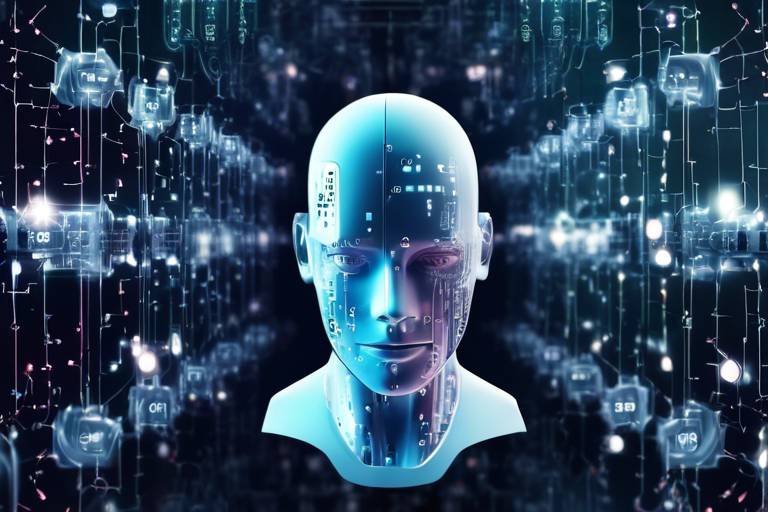The Strength of AI in Cyber Threat Detection
In today's digital landscape, where cyber threats lurk around every corner, the emergence of artificial intelligence (AI) has revolutionized the way we approach cybersecurity. Imagine a world where machines can think, learn, and adapt to emerging threats faster than any human could. This is not just a fantasy; it's the reality we are stepping into, thanks to the transformative power of AI. The integration of AI technologies into cybersecurity practices has not only enhanced our ability to detect threats but has also reshaped how we respond to them. With the volume of data generated every second, traditional methods of threat detection simply can’t keep up. This is where the strength of AI truly shines, offering us a beacon of hope in an increasingly perilous online environment.
AI-driven systems are capable of analyzing vast datasets, identifying patterns, and recognizing anomalies that might indicate a potential breach. Think of it as having a highly skilled detective who can sift through mountains of information in seconds, pinpointing suspicious activity that would take a human analyst hours, if not days, to uncover. As we delve deeper into the capabilities of AI in cyber threat detection, we will explore how machine learning and deep learning techniques play a pivotal role, the challenges we face in implementation, and what the future holds for AI in this crucial field.
At the heart of AI's prowess in cybersecurity lies machine learning. This subset of AI focuses on developing algorithms that can learn from and make predictions based on data. By analyzing vast datasets, machine learning algorithms can identify patterns and anomalies that may signify a cyber attack. Imagine a security system that learns from every attempted breach, continuously improving its defenses. This proactive approach allows organizations to stay one step ahead of cybercriminals, effectively mitigating risks before they escalate into full-blown attacks.
While machine learning provides a solid foundation, deep learning takes it a step further. Utilizing complex neural networks, deep learning models can analyze intricate data structures, making them particularly effective for sophisticated threat detection. These models can process data in ways that mimic human thought processes, allowing them to identify subtle indicators of malicious behavior that traditional methods might miss.
Neural networks are the backbone of deep learning techniques. They are designed to mimic the way the human brain operates, processing information through interconnected layers. Each layer extracts features from the data, gradually building a comprehensive understanding that is essential for recognizing cyber threats. This layered approach enables neural networks to tackle complex problems, making them invaluable in the fight against cybercrime.
The effectiveness of neural networks hinges on training. This process involves feeding large amounts of labeled data into the network, allowing it to learn and refine its detection capabilities over time. The more data the network processes, the better it becomes at identifying potential threats. However, this requires significant computational resources and expertise, which can be a barrier for some organizations.
Neural networks have a variety of applications in cybersecurity, including:
- Malware Detection: Identifying and neutralizing harmful software before it can cause damage.
- Intrusion Detection Systems: Monitoring network traffic for suspicious activity and potential breaches.
- Fraud Prevention: Analyzing transaction patterns to detect and prevent fraudulent activities.
Despite the remarkable potential of AI in cybersecurity, several challenges remain. Issues such as data quality, model interpretability, and resource requirements can hinder the successful implementation of machine learning and deep learning technologies. Organizations must ensure they have access to high-quality data and the necessary infrastructure to support these advanced systems. Additionally, understanding how these models make decisions is crucial for gaining trust and ensuring accountability in automated systems.
One of the standout features of AI in cybersecurity is its ability to conduct real-time threat analysis. AI systems can process incoming data and analyze threats almost instantaneously, providing organizations with timely alerts and actionable insights. This rapid response capability is vital in today's fast-paced digital environment, where every second counts when it comes to preventing breaches.
To further enhance response times, many organizations are leveraging automated response mechanisms. These AI-driven systems can initiate countermeasures against detected threats automatically, significantly reducing the time it takes to mitigate potential damage. Picture a fire alarm that not only alerts you to danger but also activates the sprinklers to extinguish the flames before they spread. This level of automation can be a game-changer in cybersecurity.
Integrating AI-driven solutions with existing cybersecurity infrastructure is essential for maximizing effectiveness. By combining traditional cybersecurity measures with advanced AI technologies, organizations can create a robust defense system. This hybrid approach allows them to leverage the strengths of both worlds, enhancing overall protection against evolving threats.
Looking ahead, the future of AI in cybersecurity is incredibly promising. We can expect advancements such as predictive analytics, which will allow organizations to anticipate threats before they occur. Improved threat intelligence will enhance our understanding of the cyber threat landscape, while increased collaboration between human analysts and AI systems will create a more formidable defense against cybercriminals. As we continue to navigate this digital age, embracing AI's potential will be crucial in safeguarding our online environments.
1. How does AI improve cybersecurity?
AI enhances cybersecurity by analyzing vast amounts of data to identify patterns and anomalies that indicate potential threats, allowing for faster and more accurate threat detection.
2. What are the main challenges of implementing AI in cybersecurity?
Challenges include data quality, the need for significant computational resources, model interpretability, and ensuring that systems can integrate seamlessly with existing technologies.
3. Can AI systems respond to threats automatically?
Yes, many AI systems can initiate automated responses to detected threats, significantly reducing response times and minimizing potential damage.

The Role of Machine Learning
In today's digital landscape, the role of machine learning in cybersecurity cannot be overstated. As cyber threats become increasingly sophisticated, traditional methods of detection and prevention are often inadequate. This is where machine learning steps in, acting as a powerful ally in the fight against cybercrime. By analyzing vast amounts of data, machine learning algorithms can identify patterns and anomalies that would be nearly impossible for humans to detect. Imagine having a highly skilled detective who never sleeps, tirelessly sifting through mountains of data to spot the slightest irregularities. That's the essence of machine learning in cybersecurity.
One of the most significant advantages of machine learning is its ability to learn and adapt over time. Unlike static systems that rely on predefined rules, machine learning models improve their accuracy as they are exposed to more data. This continuous learning process allows organizations to stay one step ahead of cybercriminals. For instance, when a new type of malware is detected, machine learning algorithms can analyze its behavior and quickly update their models to recognize similar threats in the future. This proactive approach is crucial in a world where cyber threats are constantly evolving.
Furthermore, machine learning can enhance threat detection in several key areas:
- Data Analysis: Machine learning algorithms can process and analyze large datasets from various sources, enabling faster identification of potential threats.
- Anomaly Detection: By establishing a baseline of normal behavior, these algorithms can flag unusual activities that may indicate a breach.
- Predictive Analytics: Machine learning can forecast potential threats based on historical data, allowing organizations to implement preventive measures before an attack occurs.
To illustrate the impact of machine learning in cybersecurity, consider a scenario where an organization faces a series of phishing attacks. Traditional systems may struggle to keep up with the ever-changing tactics used by attackers. However, a machine learning model, trained on past phishing attempts, can quickly recognize patterns and flag suspicious emails in real-time. This capability not only protects sensitive information but also saves valuable time for security teams who can focus on more complex issues.
Despite its many advantages, the implementation of machine learning in cybersecurity is not without challenges. Organizations must ensure they have access to high-quality data for training their models. Additionally, the complexity of these algorithms can make it difficult for security professionals to interpret their findings. Nevertheless, the benefits of machine learning far outweigh the challenges, and as technology continues to advance, its role in cybersecurity will only grow stronger.
In conclusion, machine learning is revolutionizing the way we approach cyber threat detection. By harnessing the power of data and advanced algorithms, organizations can proactively defend against a wide array of cyber threats. As we continue to navigate this digital age, the integration of machine learning into cybersecurity strategies will be essential for maintaining robust defenses and safeguarding sensitive information.
- What is machine learning? Machine learning is a subset of artificial intelligence that enables systems to learn from data and improve their performance over time without being explicitly programmed.
- How does machine learning enhance cybersecurity? Machine learning enhances cybersecurity by analyzing large volumes of data to identify patterns, detect anomalies, and predict potential threats, allowing for proactive measures.
- What are the challenges of implementing machine learning in cybersecurity? Challenges include ensuring data quality, model interpretability, and the resource requirements needed to develop and maintain machine learning systems.

Deep Learning Techniques
Deep learning has revolutionized the way we approach cybersecurity, providing tools that allow for a more nuanced understanding of potential threats. At its core, deep learning employs neural networks, which are designed to mimic the human brain's ability to recognize patterns and make decisions. This capability is particularly useful in cybersecurity, where the landscape is constantly evolving, and traditional methods often fall short. By utilizing deep learning, organizations can enhance their threat detection capabilities, identifying complex attack vectors that would otherwise go unnoticed.
One of the most significant advantages of deep learning in cybersecurity is its ability to analyze vast amounts of data. Imagine trying to find a needle in a haystack; traditional methods might require sifting through each straw, but deep learning algorithms can quickly scan through the entire haystack, pinpointing the needle with remarkable accuracy. This is achieved through multiple layers of processing, where each layer extracts different features from the data. The result? A sophisticated analysis that can detect anomalies and potential threats with a high degree of precision.
To give you a clearer picture, let’s break down how deep learning techniques work in the context of cybersecurity:
- Data Input: Large datasets, including network traffic logs, user behavior data, and historical attack patterns, are fed into the system.
- Feature Extraction: The neural network processes this data through various layers, automatically identifying relevant features that indicate a potential threat.
- Pattern Recognition: By recognizing patterns in the data, the system can differentiate between normal behavior and anomalies that could signify a cyber attack.
- Decision Making: Finally, the model outputs predictions or classifications, alerting security teams to potential threats in real-time.
However, while deep learning offers remarkable capabilities, it’s important to recognize that it’s not a silver bullet. The effectiveness of these models heavily depends on the quality and quantity of the data used for training. If the data is biased or incomplete, the outcomes can be misleading, leading to false positives or missed threats. This challenge highlights the need for organizations to invest not only in advanced technologies but also in robust data management practices.
In summary, deep learning techniques represent a powerful ally in the fight against cyber threats. By leveraging neural networks, organizations can achieve a level of analysis and detection that was previously unattainable. As we continue to navigate the complexities of the digital landscape, embracing these advanced techniques will be crucial for maintaining security and protecting sensitive information.

Neural Networks Explained
Neural networks are the backbone of many modern artificial intelligence systems, especially in the realm of cybersecurity. They are designed to mimic the way the human brain operates, processing vast amounts of information through interconnected layers of nodes. Each node, or neuron, receives input, performs a mathematical operation, and passes the output to the next layer. This layered approach allows neural networks to identify intricate patterns and relationships within the data, which is crucial for detecting cyber threats.
At their core, neural networks consist of three main types of layers: the input layer, hidden layers, and the output layer. The input layer receives the raw data, such as network traffic or user behavior, while the hidden layers perform complex computations to extract features and patterns. Finally, the output layer produces the final prediction or classification, such as whether a specific action is benign or malicious.
One of the remarkable aspects of neural networks is their ability to learn from data. This learning process is achieved through a method called backpropagation, where the network adjusts its internal parameters based on the errors it makes during training. To train a neural network effectively, it requires a substantial amount of labeled data, which serves as a reference for what constitutes normal behavior versus potential threats. The more data the network processes, the better it becomes at recognizing subtle anomalies that could indicate a cyber attack.
Neural networks excel in various applications within cybersecurity, including:
- Malware Detection: By analyzing file behaviors and characteristics, neural networks can identify and classify malware, even variants that have not been previously encountered.
- Intrusion Detection Systems: These systems monitor network traffic in real-time, using neural networks to flag suspicious activities that deviate from established patterns.
- Fraud Prevention: In financial sectors, neural networks analyze transaction data to detect fraudulent activities, protecting both organizations and consumers.
However, the implementation of neural networks in cybersecurity is not without its hurdles. Issues such as the quality of data, the interpretability of the models, and the computational resources required can complicate the deployment of these advanced systems. Nevertheless, as technology continues to advance, the potential for neural networks to revolutionize threat detection and response in cybersecurity remains incredibly promising.
- What are neural networks? Neural networks are computational models inspired by the human brain, designed to recognize patterns and make predictions based on data.
- How do neural networks learn? They learn through a process called backpropagation, adjusting their internal parameters based on errors made during training.
- What are some applications of neural networks in cybersecurity? They are used in malware detection, intrusion detection systems, and fraud prevention.

Training Neural Networks
Training neural networks is a critical step in harnessing their power for effective cyber threat detection. At its core, this process involves feeding a neural network vast amounts of labeled data, which serves as the foundation for the network to learn and adapt. Imagine teaching a child to recognize different animals; you show them pictures of cats, dogs, and birds, explaining what each one is. Similarly, during training, the neural network is exposed to numerous examples of both malicious and benign data, allowing it to grasp the subtle differences that define each category.
One of the challenges in this training phase is ensuring the quality of the data. The effectiveness of a neural network is heavily dependent on the diversity and accuracy of the training data. If the dataset is biased or lacks variety, the network may struggle to generalize its learning to real-world scenarios. This is akin to a student who only studies from one textbook; they may excel in that specific context but falter when faced with practical applications.
The training process typically involves several key stages:
- Data Collection: Gathering a comprehensive dataset that includes various examples of cyber threats and normal behavior.
- Preprocessing: Cleaning and normalizing the data to ensure that it is suitable for analysis.
- Model Selection: Choosing an appropriate neural network architecture, such as convolutional neural networks (CNNs) or recurrent neural networks (RNNs), depending on the nature of the data.
- Training: Feeding the preprocessed data into the model, allowing it to learn through forward propagation and backpropagation techniques.
- Evaluation: Testing the model on unseen data to assess its performance and make necessary adjustments.
As the neural network trains, it continuously adjusts its internal parameters to minimize the error rate, which is the difference between its predictions and the actual outcomes. This iterative process can be computationally intensive, requiring significant resources. However, the payoff is immense; a well-trained neural network can identify cyber threats with remarkable accuracy, often outperforming traditional methods.
In conclusion, training neural networks is not just about feeding data; it’s a complex, nuanced process that combines art and science. By investing time and resources into effective training, organizations can unlock the full potential of AI in cybersecurity, paving the way for a safer digital landscape.
Q1: What is the importance of labeled data in training neural networks?
A1: Labeled data is crucial because it provides the neural network with examples of what to learn from, helping it distinguish between different types of inputs, such as malicious and benign data.
Q2: How long does it take to train a neural network?
A2: The training duration can vary widely based on the complexity of the model, the size of the dataset, and the computational resources available. It can range from a few hours to several weeks.
Q3: Can neural networks adapt to new types of cyber threats?
A3: Yes, once trained, neural networks can be updated with new data to adapt to emerging threats. Continuous learning is essential for maintaining their effectiveness in a rapidly evolving cyber landscape.

Applications in Cybersecurity
In the ever-evolving landscape of cybersecurity, the applications of neural networks and advanced AI techniques have become pivotal. These technologies are not just buzzwords; they are actively reshaping how organizations defend against cyber threats. One of the most significant applications is in malware detection. Traditional methods often rely on signature-based detection, which can be insufficient against new or modified malware. However, AI-driven systems analyze the behavior of files and applications in real-time, identifying malicious patterns that may not have been previously documented.
Another critical area where AI shines is in intrusion detection systems (IDS). These systems monitor network traffic for suspicious activities and potential threats. By employing machine learning algorithms, IDS can adapt and learn from the traffic patterns within a network, improving their ability to flag anomalies that might indicate a breach. This proactive approach significantly reduces the risk of successful attacks, as potential threats can be identified and mitigated before they escalate.
Moreover, AI is making waves in fraud prevention. Financial institutions, for instance, utilize AI to analyze transaction data in real-time. By recognizing unusual patterns that deviate from a user’s typical behavior, these systems can flag potential fraud attempts and alert security teams immediately. This not only helps in protecting sensitive information but also enhances customer trust in the institution’s security measures.
To illustrate the diverse applications of AI in cybersecurity, consider the following table:
| Application | Description | Benefits |
|---|---|---|
| Malware Detection | Identifies malicious software using behavioral analysis. | Proactive threat identification, reduced risk of infection. |
| Intrusion Detection Systems | Monitors network traffic for suspicious activities. | Real-time threat detection, adaptive learning. |
| Fraud Prevention | Analyzes transaction data to detect unusual patterns. | Immediate alerts, enhanced customer trust. |
Additionally, AI is being leveraged for vulnerability management. By scanning systems and applications for known vulnerabilities, AI can prioritize risks based on their potential impact and likelihood of being exploited. This allows organizations to allocate resources more effectively, focusing on the most critical areas that require immediate attention.
Another exciting application is in security automation. AI-driven tools can automate repetitive security tasks, such as log analysis and incident response. This not only frees up valuable time for cybersecurity professionals but also ensures that responses to incidents are swift and consistent, minimizing the window of opportunity for attackers.
In conclusion, the applications of AI and neural networks in cybersecurity are vast and varied. From malware detection to fraud prevention, these technologies are revolutionizing how organizations approach security. As cyber threats continue to evolve, embracing AI-driven solutions will be essential for maintaining robust defenses and ensuring the protection of sensitive data.
- What is the primary benefit of using AI in cybersecurity?
AI enhances threat detection capabilities, allowing for quicker identification and response to potential breaches. - How do neural networks improve malware detection?
Neural networks analyze the behavior of files rather than relying solely on known signatures, making them effective against new malware. - Can AI systems operate in real-time?
Yes, AI systems can analyze threats in real-time, providing organizations with immediate alerts and actionable insights. - What challenges do organizations face when implementing AI in cybersecurity?
Challenges include data quality, model interpretability, and the need for significant computational resources.

Challenges in Implementation
While the adoption of artificial intelligence (AI) and machine learning (ML) in cybersecurity presents exciting opportunities, it is not without its challenges. Organizations aiming to implement these advanced technologies often encounter several hurdles that can impede their effectiveness. One of the most significant challenges is the quality of data used to train AI models. Poor-quality data can lead to inaccurate predictions and missed threats, which can have dire consequences for an organization's security posture.
Moreover, the interpretability of AI models poses another challenge. Many AI systems, especially those based on deep learning, operate as "black boxes," making it difficult for cybersecurity professionals to understand how decisions are made. This lack of transparency can hinder trust in automated systems and complicate compliance with regulatory requirements that necessitate clear accountability for security measures.
Additionally, the resource requirements for implementing AI and ML solutions can be daunting. Organizations often need to invest in specialized hardware, software, and skilled personnel. This can be particularly challenging for smaller businesses that may lack the budget or expertise to deploy such advanced technologies effectively. To help illustrate these challenges, consider the following table:
| Challenge | Description |
|---|---|
| Data Quality | Poor-quality or biased data can lead to ineffective threat detection. |
| Model Interpretability | Complex models can be difficult to understand, leading to a lack of trust. |
| Resource Requirements | High costs and need for specialized skills can limit accessibility. |
Furthermore, organizations must also consider the integration of AI solutions with existing systems. Many cybersecurity infrastructures are built on legacy systems that may not be compatible with new AI technologies. This can lead to operational silos, where valuable insights from AI-driven tools are not fully utilized due to poor integration.
In conclusion, while the potential of AI in cybersecurity is immense, organizations must navigate these challenges carefully. By addressing data quality, enhancing model interpretability, managing resource allocation, and ensuring seamless integration, businesses can better position themselves to reap the benefits of AI-driven cybersecurity solutions.
- What are the main challenges in implementing AI in cybersecurity? The main challenges include data quality, model interpretability, resource requirements, and integration with existing systems.
- How can organizations improve data quality for AI models? Organizations can enhance data quality by ensuring comprehensive data collection, regular data cleaning, and bias mitigation strategies.
- Is AI fully reliable in detecting cyber threats? While AI significantly improves threat detection, it is not foolproof. It should complement human expertise rather than replace it.
- What steps can be taken to improve model interpretability? Techniques such as explainable AI (XAI) can help make AI models more transparent and understandable.

Real-time Threat Analysis
In today’s fast-paced digital landscape, the ability to conduct is not just a luxury; it’s a necessity. As cyber threats evolve at an alarming rate, organizations must be equipped with tools that can swiftly identify and respond to potential breaches. Imagine trying to catch a speeding bullet; that’s what it feels like for cybersecurity teams when they face threats that can compromise sensitive data in seconds. AI systems, with their remarkable speed and efficiency, are stepping up to this challenge, providing organizations with timely alerts and actionable insights.
Real-time threat analysis involves the continuous monitoring of network activity, using AI algorithms that can sift through massive amounts of data. These algorithms are designed to detect unusual patterns or anomalies that could indicate a security breach. For instance, if a user suddenly accesses sensitive files at an unusual hour, the system can flag this behavior for further investigation. This proactive approach allows organizations to stay one step ahead of cybercriminals, much like a chess player anticipating their opponent's next move.
One of the key advantages of real-time threat analysis is its ability to minimize damage. When a potential threat is detected, organizations can respond immediately, often before any significant harm occurs. This rapid response is crucial, especially considering that the average time to detect a breach can range from several days to months. With AI-driven solutions, this timeframe is drastically reduced. In fact, studies have shown that organizations utilizing AI for threat detection can reduce their response time by up to 80%.
Moreover, the integration of AI in real-time threat analysis not only enhances detection but also improves the overall security posture of an organization. By analyzing historical data, AI systems can learn from past incidents and adapt their detection algorithms accordingly. This means that the more data these systems process, the smarter they become, continuously refining their ability to identify potential threats.
To illustrate the impact of real-time threat analysis, consider the following table that highlights the differences between traditional methods and AI-driven approaches:
| Aspect | Traditional Methods | AI-driven Methods |
|---|---|---|
| Detection Speed | Days to Weeks | Seconds to Minutes |
| Data Processing | Manual Analysis | Automated Analysis |
| Adaptability | Static Rules | Dynamic Learning |
| Response Time | Slow | Immediate |
As organizations increasingly adopt AI technologies for real-time threat analysis, it's essential to understand that these systems are not a replacement for human analysts. Instead, they act as powerful allies, augmenting human capabilities. Cybersecurity professionals can focus on complex decision-making and strategy while AI handles the heavy lifting of data analysis and threat detection. This collaboration between human ingenuity and machine efficiency creates a robust defense against cyber threats.
In conclusion, the integration of AI in real-time threat analysis is revolutionizing how organizations approach cybersecurity. By providing immediate insights and enabling swift responses, AI empowers businesses to protect their digital assets more effectively. As the cyber threat landscape continues to evolve, investing in real-time threat analysis will be crucial for any organization looking to safeguard its future.
- What is real-time threat analysis? Real-time threat analysis is the continuous monitoring of network activity to detect and respond to potential security breaches as they occur.
- How does AI improve threat detection? AI enhances threat detection by analyzing vast amounts of data quickly, identifying patterns and anomalies that may indicate a cyber threat.
- Can AI completely replace human analysts in cybersecurity? No, AI is designed to augment human capabilities, allowing analysts to focus on strategic decision-making while AI handles data processing and threat detection.
- What are the benefits of using AI for real-time threat analysis? Benefits include faster detection and response times, improved adaptability to new threats, and reduced damage from potential breaches.

Automated Response Mechanisms
In today's fast-paced digital landscape, the ability to respond to cyber threats swiftly is not just an advantage; it's a necessity. This is where come into play, revolutionizing how organizations tackle potential breaches. Imagine having a digital security guard that never sleeps, always on the lookout for suspicious activity, ready to spring into action at a moment's notice. That's the power of AI-driven automation in cybersecurity.
Automated response mechanisms utilize advanced algorithms to detect threats and initiate countermeasures without human intervention. This is crucial because, in many cases, cyberattacks occur at lightning speed, leaving little time for manual responses. By leveraging AI, organizations can significantly reduce their response time, often to mere seconds. For instance, when a potential threat is detected, the system can automatically isolate the affected network segment, block malicious IP addresses, or even deploy patches to vulnerable systems—all without waiting for a human analyst to step in.
Moreover, these mechanisms can be customized based on the organization's specific needs and threat landscape. For example, a financial institution might prioritize fraud detection and prevention, while a healthcare provider might focus on protecting sensitive patient data. By tailoring automated responses to align with business objectives, organizations can enhance their security posture while minimizing the impact of cyber incidents.
However, it's essential to recognize that while automation can significantly enhance response capabilities, it is not a silver bullet. There are potential pitfalls to consider. For instance, automated systems must be carefully calibrated to avoid false positives—situations where legitimate activities are flagged as threats. This can lead to unnecessary disruptions and a phenomenon known as alert fatigue, where security teams become overwhelmed by alerts, potentially overlooking genuine threats.
To mitigate these challenges, organizations often implement a tiered response system, where automated actions are complemented by human oversight. This hybrid approach ensures that while the system can act swiftly, human analysts can provide the contextual understanding necessary to make informed decisions. In this way, the strengths of both AI and human expertise are harnessed, creating a more robust defense against evolving cyber threats.
In conclusion, automated response mechanisms represent a significant advancement in the field of cybersecurity. By enabling organizations to respond to threats in real-time, they not only enhance security but also free up valuable resources for security teams to focus on more strategic initiatives. As cyber threats continue to evolve, the integration of AI-driven automation will undoubtedly play a critical role in shaping the future of cybersecurity.
- What are automated response mechanisms?
Automated response mechanisms are AI-driven systems that detect and respond to cyber threats without human intervention, allowing for rapid action against potential breaches. - How do automated response mechanisms improve cybersecurity?
They reduce response times, decrease the likelihood of human error, and allow security teams to focus on more complex tasks by handling routine threats automatically. - What are the challenges of implementing automated response mechanisms?
Challenges include the risk of false positives, the need for careful calibration, and ensuring that automated actions align with organizational goals. - Can automated systems replace human analysts?
No, while they can handle routine tasks efficiently, human oversight is crucial for understanding context and making informed decisions during complex incidents.

Integration with Existing Systems
Integrating AI-driven solutions with existing cybersecurity infrastructure is like adding a turbocharger to an already powerful engine. It enhances performance, efficiency, and effectiveness in combating cyber threats. Many organizations have legacy systems that are deeply entrenched in their operations, and the idea of overlaying AI technology can seem daunting. However, when done correctly, this integration not only fortifies the security posture but also streamlines operations.
The key to successful integration lies in understanding the current systems in place. Organizations must conduct a thorough assessment of their existing cybersecurity framework to identify areas where AI can add the most value. For instance, traditional security measures like firewalls and antivirus software can be augmented with AI analytics to provide a more comprehensive view of the threat landscape. By doing so, organizations can leverage both traditional and advanced technologies, creating a multi-layered defense strategy that is more resilient against evolving threats.
Moreover, the integration process often involves several crucial steps:
- Assessment: Evaluate existing systems and identify gaps that AI can fill.
- Compatibility: Ensure that the AI tools can communicate effectively with the current infrastructure.
- Training: Provide training for staff to understand and utilize the new AI capabilities.
- Testing: Implement rigorous testing to ensure that the integrated systems work harmoniously.
One of the significant benefits of integrating AI with existing systems is the ability to harness data from various sources. AI can analyze logs, alerts, and other data streams in real-time, providing insights that were previously unattainable. This capability allows security teams to respond to incidents faster and more effectively. For example, an AI system can correlate data from intrusion detection systems with user behavior analytics, revealing potential threats that a human analyst might overlook.
However, organizations must also be mindful of the challenges that come with integration. Issues such as data silos, lack of interoperability, and resistance to change can hinder the process. To mitigate these challenges, organizations should foster a culture of collaboration between IT and cybersecurity teams, ensuring that everyone is on the same page when it comes to security priorities.
In conclusion, the integration of AI-driven solutions with existing cybersecurity systems is not just an option; it’s becoming a necessity in today’s digital landscape. By embracing this integration, organizations can significantly enhance their defenses, making them more agile and responsive to potential threats. As we move forward, the synergy between AI and traditional security measures will define the future of cybersecurity, paving the way for a more secure digital environment.
- What are the benefits of integrating AI with existing cybersecurity systems?
Integrating AI enhances threat detection capabilities, improves response times, and provides comprehensive insights from various data sources.
- What challenges might organizations face during integration?
Challenges include data silos, lack of interoperability, and resistance to change among staff members.
- How can organizations ensure successful integration?
By conducting thorough assessments, ensuring compatibility, providing training, and implementing rigorous testing.

The Future of AI in Cybersecurity
The future of AI in cybersecurity is not just bright; it's practically dazzling! As technology evolves, so do the methods employed by cybercriminals, making it crucial for organizations to stay ahead of the curve. Imagine a world where AI systems not only detect threats but also predict them before they even occur. This is the direction we are heading towards, with advancements in predictive analytics and a deeper integration of AI into our cybersecurity frameworks.
One of the most exciting prospects is the enhancement of threat intelligence. AI can analyze vast amounts of data from various sources, identifying emerging threats and trends that human analysts might overlook. By correlating data points and drawing insights from historical incidents, AI can provide organizations with a proactive stance against potential attacks. This means that instead of merely reacting to threats, companies can anticipate them, much like a chess player thinking several moves ahead.
Moreover, the collaboration between human analysts and AI systems is set to transform the cybersecurity landscape. While AI can handle the heavy lifting of data analysis and threat detection, human expertise is irreplaceable when it comes to strategic decision-making and understanding the context of threats. This partnership can lead to more effective responses, ensuring that organizations are not only protected but are also learning from each incident to improve their defenses. It's a bit like having a seasoned detective working alongside a brilliant computer, each enhancing the other's capabilities.
As we look further into the future, we can expect to see improvements in several key areas:
- Adaptive Learning: AI systems will become increasingly adept at learning from new data in real-time, allowing them to adapt to new threats as they emerge.
- Enhanced Automation: The automation of routine cybersecurity tasks will free up human resources for more complex problem-solving and strategic initiatives.
- Interoperability: Future AI systems will be designed to work seamlessly with existing cybersecurity tools, creating a more unified defense strategy.
In conclusion, the future of AI in cybersecurity is not just about making existing systems smarter; it's about reimagining how we approach security as a whole. With AI's potential for predictive analytics, enhanced threat intelligence, and improved collaboration, organizations will be better equipped to tackle the ever-evolving landscape of cyber threats. The key will be to embrace these advancements while also remaining vigilant and adaptable, ensuring that we stay one step ahead of those who would do us harm.
Q1: How does AI improve threat detection in cybersecurity?
AI improves threat detection by analyzing large datasets to identify patterns and anomalies that may indicate a cyber threat. Machine learning algorithms can learn from past incidents and adapt to new threats, making them more effective over time.
Q2: What role do neural networks play in AI cybersecurity solutions?
Neural networks mimic the way the human brain processes information, allowing AI systems to recognize complex patterns in data. This is crucial for accurately identifying and responding to sophisticated cyber threats.
Q3: What are the challenges of implementing AI in cybersecurity?
Challenges include data quality, model interpretability, and the resource requirements needed to train and maintain AI systems. Organizations must also address the integration of AI with existing cybersecurity infrastructure.
Q4: Will AI replace human analysts in cybersecurity?
While AI can automate many tasks and enhance threat detection, it is unlikely to fully replace human analysts. The collaboration between AI and human expertise is essential for effective cybersecurity.
Frequently Asked Questions
- What is the role of AI in cyber threat detection?
AI plays a crucial role in cyber threat detection by analyzing large volumes of data to identify patterns and anomalies. This enables organizations to take proactive measures against potential cyber attacks, making their defenses stronger and more effective.
- How does machine learning enhance threat detection?
Machine learning enhances threat detection by utilizing algorithms that sift through massive datasets to recognize unusual behaviors or trends. This capability allows security systems to adapt and improve their responses to emerging threats over time.
- What are neural networks, and why are they important?
Neural networks are a type of AI that mimic the way the human brain processes information. They are essential in cybersecurity because they can identify complex patterns in data, which helps in recognizing sophisticated cyber threats that traditional methods might miss.
- What challenges do organizations face when implementing AI in cybersecurity?
Organizations face several challenges when implementing AI for cybersecurity, including ensuring data quality, understanding model interpretability, and managing resource requirements. These factors can complicate the deployment of effective AI solutions.
- How does AI provide real-time threat analysis?
AI systems can analyze incoming data in real-time, allowing them to detect threats as they occur. This capability provides organizations with timely alerts and actionable insights, enabling swift responses to potential breaches and minimizing damage.
- What are automated response mechanisms in AI?
Automated response mechanisms are AI-driven systems that can initiate countermeasures against detected threats without human intervention. This reduces response time significantly, allowing organizations to mitigate risks quickly and efficiently.
- How can AI be integrated with existing cybersecurity systems?
Integrating AI with existing cybersecurity infrastructure enhances overall effectiveness by combining traditional security measures with advanced AI technologies. This synergy allows organizations to strengthen their defenses and adapt to evolving threats.
- What does the future hold for AI in cybersecurity?
The future of AI in cybersecurity looks promising, with advancements such as predictive analytics, improved threat intelligence, and better collaboration between human analysts and AI systems. These developments will help organizations combat increasingly sophisticated cyber threats.



















